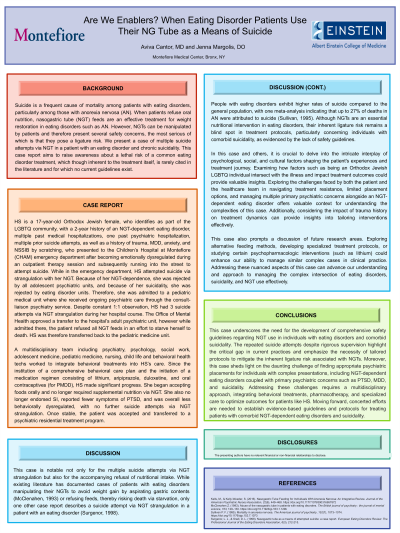Suicidality and Behavioral Emergencies
(181) Are We Enablers? When Eating Disorder Patients Use Their NG Tube as a Means of Suicide

- AC
Aviva Cantor, MD
Resident Physician
Montefiore Medical Center
New York, New York - JM
Jenna Margolis, DO
Child and Adolescent Psychiatry Consultation Liaison Director
Montefiore/Einstein
New York, New York
Presenting Author(s)
Co-Author(s)
Background/Significance: Suicide is a frequent cause of mortality among patients with eating disorders, particularly anorexia nervosa (AN). Although nasogastric tube (NGT) feeds are an effective treatment for eating disorders such as AN (Kells, 2016), they pose a ligature risk. We present a case of multiple suicide attempts via NGT in a patient with an eating disorder and chronic suicidality.
Case: HS is a 17-year-old female, who identifies as part of the LGBTQ community, with a history of an NGT-dependent eating disorder for almost 2 years, multiple past hospitalizations, multiple prior suicide attempts, as well as a history of trauma, MDD, anxiety, and NSSIB, who presented to the emergency department after running into the street to attempt suicide after becoming emotionally dysregulated in a therapy session. While in the emergency department, she attempted suicide via strangulation with her NGT. Because of her NGT-dependence, she was rejected by all adolescent psychiatric units, and because of her suicidality, she was rejected by eating disorder units. Therefore, she was admitted to a pediatric medical unit where she received ongoing psychiatric care through the consult-liaison psychiatry service. Despite constant 1:1 observation, HS had 3 suicide attempts via NGT strangulation during her hospital course. Although the Office of Mental Health approved a transfer to the hospital’s adult psychiatric unit, the patient ultimately was readmitted to the medical unit after refusing all NGT feeds in an effort to starve herself to death.
Discussion: People with eating disorders have higher rates of suicide compared to the general population, with one meta-analysis showing up to 27% of deaths in AN were due to suicide (McSullivan, 1995). Although NGTs are an essential nutritional intervention in eating disorders including AN and ARFID, their inherent ligature risk remains a blind spot in the treatment of eating disorders, as there are no safety guidelines for the use of NGTs in people with comorbid suicidality. Only one other case report in the literature describes a suicide attempt via strangulation by NGT in a patient with an eating disorder (Surgenor, 1998). Other risks posed by NGTs have been described, including patient manipulation of the tube to aspirate gastric contents (McClenahen, 1993). However, the severity of this presentation highlights a unique challenge in treating comorbid NGT-dependent eating disorders and suicidality.
Conclusion/Implications: Safety guidelines addressing the suicide risk presented by NGT treatment need to be developed given the high prevalence of suicidality in the eating disorder population.
References:
Kells M, Kelly-Weeder S. Nasogastric Tube Feeding for Individuals With Anorexia Nervosa: An Integrative Review. J Am Psychiatr Nurses Assoc. 2016 Nov;22(6):449-468. doi: 10.1177/1078390316657872. Epub 2016 Aug 12. PMID: 27519612.
McClenahen Z. Abuse of the nasogastric tube in patients with eating disorders. Br J Psychiatry. 1993 Jul;163:129-30. doi: 10.1192/bjp.163.1.129b. PMID: 8353692.
Sullivan PF. Mortality in anorexia nervosa. Am J Psychiatry. 1995 Jul;152(7):1073-4. doi: 10.1176/ajp.152.7.1073. PMID: 7793446.
Surgenor, L.J. and Snell, D.L. (1998). Nasogastric tube as a means of attempted suicide: a case report. Eur. Eat. Disorders Rev., 6: 212-215. https://doi.org/10.1002/(SICI)1099-0968(199809)6:3< 212::AID-ERV246 >3.0.CO;2-2
Presentation Eligibility: Not previously published or presented.
Diversity, Equity, and Inclusion: For LGBTQ women, there are numerous studies on the increased risk of suicidality and limited research on the elevated risk of eating disorders. However, there is scarce if any research that serves LGBTQ women suffering from comorbid suicidality and eating disorders. As a result, there may be a significant gap in our understanding of how these bifold risks interact and challenge our understanding of traditional treatment protocols. This blindspot may cause discrepancies in care and limit innovative interventions that drive better outcomes for LGBTQ women. We hope our case highlights the need for progress in this distinctive area.

